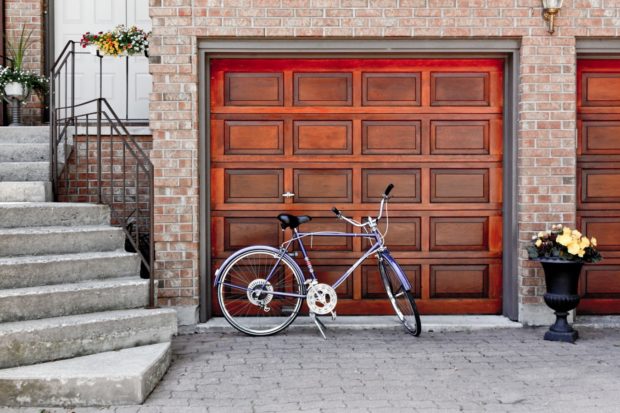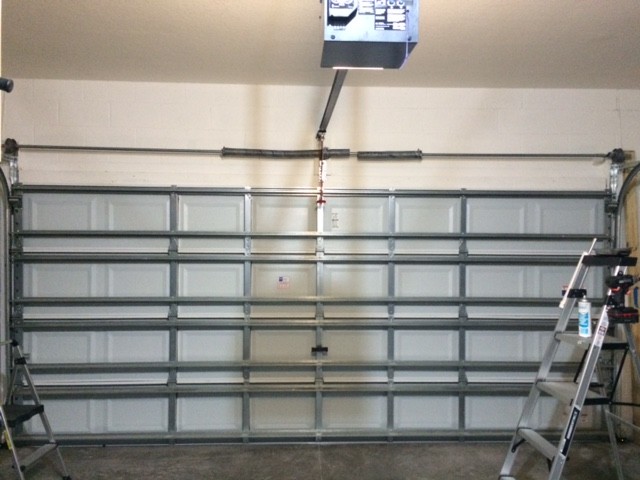While the main house gets all the attention, garages are often forgotten. Most people open and close their garage without giving much thought to it. According to the NEISS, this is an oversight which could be fatal.
If you’re having some trouble with your garage door, chances are there’s a broken spring. A garage door spring is what makes it possible to lift the garage with ease.
Continue reading to learn all there is to know about garage door springs replacement.
Types of Garage Springs
All garage doors using a counterbalance system rely on a spring to operate. The system consists of a set of pulleys, cables to transfer the force and springs.
There are two types of springs for such doors
- Extension Springs: This type of springs is normally attached to the bottom corners of the garage door.

When the door is closed, the springs are stretched. The stored energy is what helps lifts the doors open as the spring recoil. Extension door springs are less common than torsional springs.
- Torsional Springs: They are installed horizontally above the garage door. When closing the door, the cable that is attached to the bottom corners exerts a force. This causes the torsional spring to wind and energy is stored.
When you try to lift the door, the spring unwinds. This release the potential energy stored and helps lift the door with minimum effort. Failure occurs when the steel in the coils can no longer support the weight of the door.
What are the Warning Signs?
- Unusually heavy door. The spring helps pull the garage door up whether it’s open by hand or electronic. A broken spring means all the weight is carried by hand.
- The door falls too fast. A functioning spring balances the weight of the door when it’s going down. If the spring is broken there is nothing to halt the falling of the door.
- A loud bang. This is more common with torsional springs. When the spring breaks, it unwinds suddenly releasing all the tension. The energy is converted into the loud bang.
- Crooked. If an extension spring breaks. The side of the door on the damaged side dips. Since each of them carries their weight independently the garage may refuse to open or close on one side.
- A visible gap on the spring. A torsional spring consists of a spring-wound over a steel rod. A broken spring unwinds exposing the inner rod.
- Slacking cables. The tension on the spring is what keeps the cables in place. When the spring breaks, all the tension is lost and the cables get loose.

The Causes of Failure
- Wear and Tear: Even well-maintained garage springs eventually break. On average, a garage door is opened and closed 6-8 times every day. The spring weakens with each cycle. Expect a quality spring to last for 10,000 cycles before it needs replacing.
- Poor Maintenance: Maintenance prolongs the life of the spring. Simple practices such as oiling regularly goes a long way. Maintainance also makes the garage door less likely to cause an accident.
- Rust Build-Up: Springs are metallic and most metals rust. Leaks in the garage expose the spring to a lot of moisture which accelerates the rusting process. The rust increases the friction coefficient between the windings. This increases the rate of wear and tear.
- Shortcuts: Failure can occuir if the contractor installed a sub-standard spring. A typical two-car garage should have two springs, one for each side. Some contractors install one long spring instead of two. While it’s functional, it significantly reduces the lifespan of the spring.

How to Replace the Springs
The difficulty level varies depending on the type of spring being replaced. Do NOT attempt if unsure.
Extension Springs
Of the two types of springs, extension springs are the easier type to replace. Not having to deal with the spring tension is what makes it recommended for DIYers. Below are the steps
- Open the garage door to relives the tension in the spring. Ensure the garage door is secured open, you can achieve this by using a C-clamp on the tracks.
- Next, you disconnect the spring first from the bracket of the track than from the pulley system.
- You then disconnect the safety cable and install the new spring.
- Finally, reattach the pulley and the safety cable respectively. And just like that, you are done.

Torsional Springs
Unless you are a trained professional, it is not recommended to try replacing torsional garage springs by yourself.
The energy stored in the springs that are under tension is the main source of danger. Even with the help of an online tutorial, you will still have to secure the parts. This is even harder if you don’t know what you are looking for.

Assuming your better judgment will carry the day and you leave this work to the pros. Here the steps to replace torsional springs.
- Unlike extension springs, you need the door close to relieve the tension in the spring. You then need to cautiously unload all the springs. As mentioned earlier, most garage doors should have two of these. The unloading is done using winding bars.
- If the spring was broken, then the broken portion will be automatically unloaded.
- Next, you have to unbolt the torsional spring from the central bracket. Once done, detach the cables from the pulleys. Once the pulley is loose, simply slide them off the road.
- What is left is to swap out the broken spring and reassemble the system. Starting by reinstalling the cables and pulleys then securing the springs to the central bracket.
- The last step is winding up both the springs and testing the door to ensure proper tension. Winding and unwinding are done with the help of a winding cone. A standard torsional spring requires about 30-quarter turns.
Parting Shot
The question as to whether you should DIY or hire a professional depends on the level your knowledge. REMEMBER, every year thousands spend nights in the emergency room due to DIY projects gone wrong.

According to HomeAdvisor, a typical garage door spring replacement will cost you $180. This is just a ballpark. The cost depends on factors like door size, weight, and the type of spring needed. Have a professional come and take measurements to give you the exact quote.










